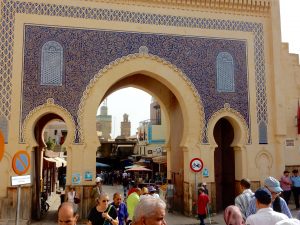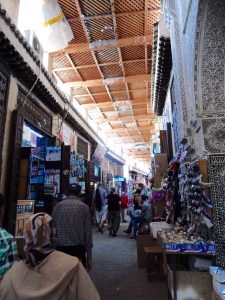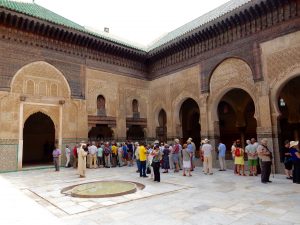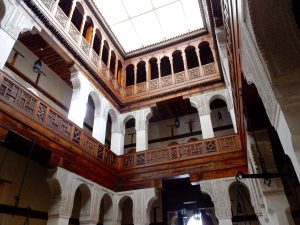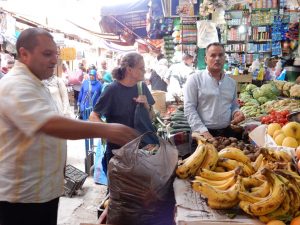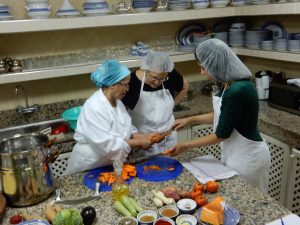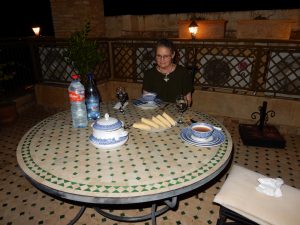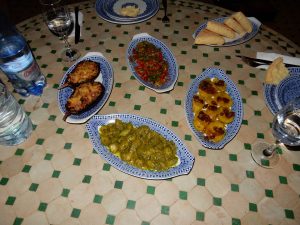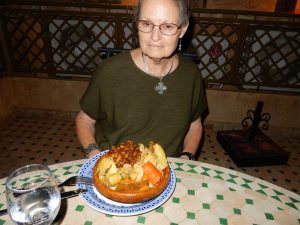October 5, 6, 7
Added about 50 pictures to a new page: Fes Pictures page.
Getting to Fes (or Fez, as Patricia insists) from Seville was pretty straightforward, even if we had to get up at 0-dark-thirty. We left the Seville apartment about 5:30 and found a cab right away–just as the rain was starting. The flights to Barcelona and Fes were relatively short and arrived on time. The Fes airport is not large and our luggage arrived quickly–the planes were small enough that carryons were restricted in size. We were met by a pleasant driver and quickly became re-acquainted with Moroccan traffic: it is one of those places where lane markings , stop signs, and speed limits are more guidelines than actual rules. [We did however, see one speed trap.]
The Ryad Alya is very nice. There are only 8 rooms and ours is spacious and pleasant. You really can’t tell what a ryad (or riad) will be like until you get inside. Ours has a good-sized courtyard with a fountain and trees and several “salons” around the outer edge. Rooms are on the the next two floors and there is a terrace on top from which we can see some of the medina. The ryad is in the old part of the city and the streets around it a difficult to navigate not least because you can’t see the sun to orient yourself.
On Monday evening we had a good dinner in the ground-level courtyard. There isn’t really a restaurant, so the cooks prepare something for you and that’s what you get served. I was prepared to not like anything but I tried everything and liked it all: soup, 4 “salads”, and a chicken tangine.
The staff at the ryad are all nice and attentive. Their English is far better than my French, but we have managed to communicate pretty well.
On Tuesday morning we had a great breakfast. I think there 5 kinds of bread, juices, coffee, really good jams and so on. It is clear that everything is prepared individually and it is all fresh, but it is still a “fixed” set of things at each sitting. Wednesday’s breakfast was equally good.
After breakfast we met the guide that the ryad had engaged for us. We had a discussion about the kinds of things we wanted (and did not want) to see and then headed out on our walking tour of the medina.
Think of the medina as a grab bag of every kind of small store you can imagine-and many that you cannot. “Small” is the key word here. Most of the shops are only 8 or 10 feet across and most of their wares are on display out front. There are shops with, for example, a single sewing machine, or one kind of lamp or cooking implement.
Some of the medina, which dates back to the 9th century, are covered but other parts are open. It is not a place that was developed for the tourist trade, but is instead one that is used by local people every day.
Our guide, Mr. Asdin (pronounced Az-deen, but I’m not sure how it is spelled), was born in the medina, which has homes as well as shops but no longer lives there. He certainly knows his way around and we threaded through the byways after him dodging pedestrians, donkeys, carts, trash, and construction. He was very informative and willing to answer questions and discuss things. We saw all the “monuments” which was his generic term for noteworthy places.
We visited mosques, medersas (schools), artisans and artists, and even a wood museum. The museum was in a restored palace and had four levels of things made of wood, tools, and information. The building itself was very nice. Unfortunately, we were not allowed to take pictures of the exhibits, which were in the palace’s original rooms aarranged around the central courtyard.
Mr. Asdin’s plan for the day was to show us a lot of the medina and he made a good attempt. We walked for almost all of the 7.5 hours we were out. We went from our ryad into the medina, headed for the oldest part, found the oldest street (a “derb”, which is a “street with a limit” , what I would call a dead end) over an old bridge into the Andalous section–it is “new,” not really getting started until the 15th century and originally populated by people (Moors, Jews, conversos, and so on) who were expelled from Spain.
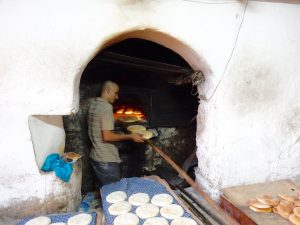
We got lessons on local life, watched bread being baked in an ancient oven (like simit bread in Istanbul), watched artisans beating copper and brass into cooking utensils, saw food being processed and hundreds of other things.
While we were trying to keep our eyes open without gawking, thousands of people were going on with their everyday business. The last time we visited the medina, three years ago, we felt rushed, but this time we had enough time to see what we wanted.
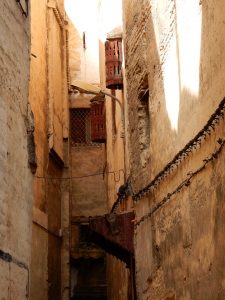
On the way back to the ryad, we stopped at a cafe where the tables were all under trees and the street came right up to the tables and had some mint tea while we discussed what we had seen. There is, of course, much more to see so we are going out with Mr. Asdin on Thursday.
We were able to eat on the terrace Tuesday night and had another interesting meal that we enjoyed a lot. It was pretty cool and windy up there, not to mention dark, so perhaps we will eat in the courtyard this evening.
Patricia is taking a cooking class today here at the ryad. This morning we went back to the medina with two of the staff and bought the ingredients for tonight’s meal. It was an interesting process and we both enjoyed it. As I write this, mid-afternoon on Wednesday, I am sitting in the courtyard next to a bubbling fountain, under a shade tree, and drinking a homemade lime concoction, and I can hear Patricia and the cooks working on the dinner. The cooking class consists of Patricia (the student), the morning and evening chefs, one of the staff to help in the kitchen, and a translator, because the cooks only speak French. It seems like an awfully noisy process.
Update: Patricia really enjoyed the cooking class and learned a great deal. The meal was a success-at least as far as I was concerned.

